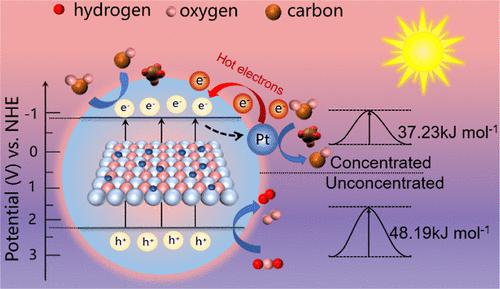当前位置:
X-MOL 学术
›
Ind. Eng. Chem. Res.
›
论文详情
Our official English website, www.x-mol.net, welcomes your
feedback! (Note: you will need to create a separate account there.)
Photothermal Coupling Effect Boosts the Conversion of CO2 to Solar Fuel Over Pt/ZnO Photocatalyst in a Concentrated Solar Reactor
Industrial & Engineering Chemistry Research ( IF 3.8 ) Pub Date : 2023-06-09 , DOI: 10.1021/acs.iecr.3c01279
Meiqi Wu 1 , Yuqi Ren 1 , Fengfan Zhu 1 , Jiancheng Zhou 1 , Quanhong Ma 1 , Kai Huang 1 , Ke Wang 1 , Naixu Li 1
Industrial & Engineering Chemistry Research ( IF 3.8 ) Pub Date : 2023-06-09 , DOI: 10.1021/acs.iecr.3c01279
Meiqi Wu 1 , Yuqi Ren 1 , Fengfan Zhu 1 , Jiancheng Zhou 1 , Quanhong Ma 1 , Kai Huang 1 , Ke Wang 1 , Naixu Li 1
Affiliation

|
The low photocatalytic reaction rate and energy conversion efficiency are the key factors restricting the direct solar-driven CO2 production of solar fuels. Here, the photothermal coupling system based on the concentrated irradiation of Fresnel lenses was designed for the light-driven CO2 conversion process. Under the condition of concentrated irradiation, the solar energy to chemical energy conversion efficiency increased from 0.012 to 0.264%, while the CO yield increased 120 times (from 0.96 to 115.32 μmol g–1 h–1) over the Pt/ZnO photocatalyst, with significant performance resulting from the increase of carrier concentration and Fermi level and the decrease of apparent activation energy. Pt nanoparticles improved the light absorption performance and surface temperature of the photocatalyst under concentrated light irradiation. Photoelectrochemical measurements, evaluation of the photocatalytic performance at different wavelengths, and apparent activation energy calculations revealed that concentrated light irradiation can be an effective way to reduce apparent activation energy (from 48.19 to 37.23 kJ/mol). This provided a potentially feasible method for efficient and green utilization of CO2 driven by solar energy.
中文翻译:

光热耦合效应在聚光太阳能反应器中通过 Pt/ZnO 光催化剂促进 CO2 向太阳能燃料的转化
光催化反应速率和能量转换效率低是制约太阳能直接驱动CO 2生产太阳能燃料的关键因素。这里,基于菲涅尔透镜集中照射的光热耦合系统被设计用于光驱动的CO 2转化过程。在集中辐照条件下,太阳能到化学能的转化效率从0.012提高到0.264%,同时CO产率提高120倍(从0.96 μmol g –1 h –1)优于 Pt/ZnO 光催化剂,由于载流子浓度和费米能级的增加以及表观活化能的降低而具有显着的性能。Pt纳米颗粒改善了光催化剂在集中光照射下的光吸收性能和表面温度。光电化学测量、不同波长下光催化性能的评估以及表观活化能计算表明,集中光照射可以是降低表观活化能(从 48.19 kJ/mol 降至 37.23 kJ/mol)的有效方法。这为太阳能驱动的CO 2高效、绿色利用提供了一种潜在可行的方法。
更新日期:2023-06-09
中文翻译:

光热耦合效应在聚光太阳能反应器中通过 Pt/ZnO 光催化剂促进 CO2 向太阳能燃料的转化
光催化反应速率和能量转换效率低是制约太阳能直接驱动CO 2生产太阳能燃料的关键因素。这里,基于菲涅尔透镜集中照射的光热耦合系统被设计用于光驱动的CO 2转化过程。在集中辐照条件下,太阳能到化学能的转化效率从0.012提高到0.264%,同时CO产率提高120倍(从0.96 μmol g –1 h –1)优于 Pt/ZnO 光催化剂,由于载流子浓度和费米能级的增加以及表观活化能的降低而具有显着的性能。Pt纳米颗粒改善了光催化剂在集中光照射下的光吸收性能和表面温度。光电化学测量、不同波长下光催化性能的评估以及表观活化能计算表明,集中光照射可以是降低表观活化能(从 48.19 kJ/mol 降至 37.23 kJ/mol)的有效方法。这为太阳能驱动的CO 2高效、绿色利用提供了一种潜在可行的方法。

































 京公网安备 11010802027423号
京公网安备 11010802027423号